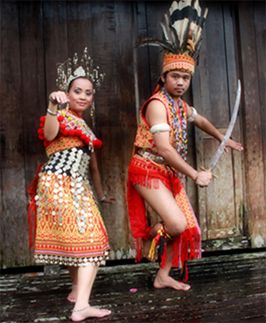Sunday, 28 February 2016
The Iban traditional costume for women is “marik empang” and kain kebat. Marik empang is a combination of beads and hand-stitched cotton decorative outer garment. It is usually red in colour. Iban women require to wear marik empang at any occasion or festival. The “ngajat” or the traditional Iban dance performed by an Iban women must wear the “marik empang” as part of the outer garment adorning her shoulder. Kain kebat, which is a cloth patterned by the ikat (tie) technique. Normally, the kain kebat is decorated with colorful stripes pattern design. It is made of cotton as well. This kain kebat is narrow and its length is only about until knee. The Iban women wear the dress consisting of kain kebat, “marik empang” which is a chest adornment, the sugu tinggi headdress and other silver ornaments such as coin belt and bangles.
The traditional garment of Iban men is called kelambi and “sirat”. There are two types of kelambi which is sleeved and sleeveless. Kelambi worn by men Iban during certain ceremonies. Cutting of kelambi is very simple which consists of a rectangular piece of cloth folded double.
The loincloth is a garment of great antiquity, is now distinctively ignored among modern Ibans. Barkcloth is the original material for loincloths. The way to tying a "sirat" is take a strip of material about 10 inches wide and 10 to 12 feet long, the end of the cloth is decorated with beautiful embroidery or weaving. Men's traditional Iban costumes wear “sirat” with a very long loincloth around the waist and between the two stocks, one end through the legs hanging in front which is dress like a apron and the other end around the waist. There should be a little “tail” (iko sirat in Iban) in the back. The loincloth worn in this way is quite secure and will not fall off. Furthermore, they also wear accessories such as a belt, armlet and anklet made from silver and a headgear decorated with hornbill feathers.
The loincloth is a garment of great antiquity, is now distinctively ignored among modern Ibans. Barkcloth is the original material for loincloths. The way to tying a "sirat" is take a strip of material about 10 inches wide and 10 to 12 feet long, the end of the cloth is decorated with beautiful embroidery or weaving. Men's traditional Iban costumes wear “sirat” with a very long loincloth around the waist and between the two stocks, one end through the legs hanging in front which is dress like a apron and the other end around the waist. There should be a little “tail” (iko sirat in Iban) in the back. The loincloth worn in this way is quite secure and will not fall off. Furthermore, they also wear accessories such as a belt, armlet and anklet made from silver and a headgear decorated with hornbill feathers.
‹



›
2/28/16
3 Photos - View album
The Iban tribe are from Sarawak, Borneo. Their traditional foods are called Pansuh food, which simply means the cooking of food or dish in a bamboo stem. It’s naturally clean, easy and simple. The food (meat, chicken, fish, vegetables and even rice together with the spices) will all be put together into the bamboo stem, then directly placed over an open fire to be cooked. The uniqueness of using the bamboo stem to cook is that the bamboo will give a special aroma and texture to the food where it’s impossible to have using other methods such as using woks.
Sunday, 14 February 2016
"Agi Idup Agi Ngelaban"
The Iban is one branch of a Dayak peoples of Borneo. In Malaysia, mostly of Ibans people are located in Sarawak. They were firstly but now formerly known during the colonial period by the British as Sea Dayaks especially in the Saribas and Skrang regions which are near the coastline and thus they had gone on expeditions along the coastline up to the Kapuas river.But nowadays, most Ibans had imigrated to the upper Rajang river since their source of food are getting lesser. nowadays, most of them had migrated to the city since some of them had their own job in the city.
It is believed that the term "Iban" originates from the Iban's own formidable enemy, the Kayan. The Kayan mostly lives in the central Broneo region and migrated into the upper Rajang river and thus went logger-head with those Ibans who migrated from the upper Batang Ai/Lupar region and Katibas river. In fact, those Sea Dayaks in the Saribas and Skrang regions initially resisted being called Iban and insisted to be called Dayak but somehow the term Iban increasingly becomes popular later on after the European starts to frequently uses this term.
Ibans were renowned for practicing headhunting and tribal/territorial expansion, and had a fearsome reputation as a strong and successful warring tribe in the past. Since the arrival of Europeans and the subsequent colonisation of the area, headhunting gradually faded out of practice although many tribal customs, practices and language continue. They live at longhouse called "Rumah Panjai" where they does not have any power supply which makes them to use oil lamp during the night and just take their bath at the river.
Nowadays, most of the Iban longhouses are equipped with modern facilities such as electricity and water supply and other facilities such as (tar sealed) roads, telephone lines and the internet. Younger Ibans are mostly found in urban areas and visit their hometowns during the holidays. The Ibans today are becoming increasingly urbanised while retaining most of their traditional heritage and culture.
Subscribe to:
Comments (Atom)







